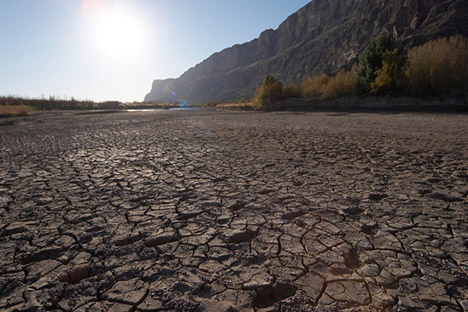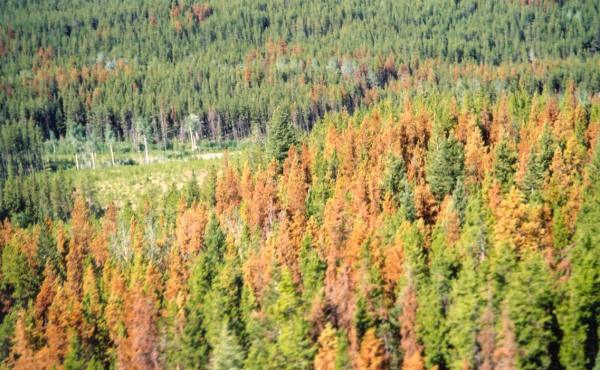Negative Effects
Negative Effects of Global Climate Change
For all of the Earth's history, numerous large and small-scale fluctuations have occurred in our world’s climate. This type of variability in climate is normal. In the modern Anthropocene era, however, increasing levels of largely anthropogenic (human-produced) atmospheric carbon dioxide (CO2), correlating with an abnormal increase in average global surface temperatures, have generated a multitude of more severe and diverse problems. If CO2 levels (and by association, global temperatures) continue to increase, there will be a variety of consequences. To name a few, it will affect human health, global sea levels, biodiversity, the migratory patterns of destructive beetles, the soil’s ability to store carbon, and the arctic way of life. If we do not act, these problems and more have the potential to inhibit the survival of the human race. It is important to emphasize that the consequences summarized below represent only a sampling, and do not run the gamut of climate change effects.
Impacts of Climate Change on Human Health
Progressively more severe weather conditions such as El Niño/La Nina cycles and hurricanes cause rising numbers of deaths throughout the world, both in areas suffering from more heat and those regions with increased or decreased precipitation patterns. Wetter conditions allow mosquito- and tick-borne illnesses to flourish and lead to such illnesses as Lyme disease and malaria. Over half of all recorded waterborne disease outbreaks in the United States have been preceded by extreme precipitation (Safarty 2009).

In addition to deaths and illnesses due to water-borne diseases, extreme heat and drought also greatly harm populations. During a particularly hot European summer in 2003, there were 70,000 more deaths than usual due to heat-related illnesses. By 2050, this number is expected to increase several-fold as this type of weather becomes more common (Safarty 2009). As the rate of photochemical reactions in the atmosphere has increased, so have the levels of ground-level ozone and pollutants. There is a strong correlation between warm days and the ozone level, with afflictions such as asthma which is more severe on warmer days (Sarfaty 2009).

Anthropogenic global climate change can be linked both to increased levels of precipitation in some parts of the planet and severe droughts in others. Critics argue that the fluctuations are still within the range of natural variability. However, even improved weather reporting systems cannot explain the higher impact of extreme weather in the 1990’s (affecting 40.8 million people) over the lower-carbon atmosphere of the 1980’s (affecting 2.8 million). (Sarfaty 2009).
Temperature, Sea Levels, and Biodiversity
While not all scientists will agree on the exact causes of recent climate changes, the fact that it is indeed changing is very well supported. The twelve warmest years over the past 150 have all been within the last thirteen years. Sea levels have risen an average of 4 cm from preindustrial times, and the average global temperature has increased .76 degrees Celsius. Three known species go extinct every hour, and the biodiversity of vertebrates is falling at a rate 10,000 times faster than any period in the past, as far as can be determined from the fossil record. According to the Intergovernmental Panel on Climate Change (IPCC), if nothing is done to mitigate the changes in climate, the “effects of climate change could cost 5-20% of the world’s GDP every year.” Therefore, we must take action (Costelo 2009).
First, we must not let the temperature rise past certain point. If the global temperature increase exceeds 2 degrees Celsius above preindustrial times, irreversible damage may occur. The world’s ice sheets, such as the arctic sea ice, the Greenland ice sheet, and the west Antarctic ice sheet, will melt as the mean global temperature increases. In addition, higher worldwide temperatures will affect the El Niño southern oscillation, Indian summer monsoon season, Amazon rainforest, and boreal forests, likely resulting in further irreparable changes to the planet’s weather patterns and biodiversity (Costello 2009).
The magnitude of these changes depends on the extent that the world’s ice sheets melt. If both the Greenland and West Antarctic ice sheets melt, direct consequences of a two degree temperature increase, sea levels could rise by up to 13 meters. This would cause drastic flooding and damage to cities and populations. Thirteen of the world’s twenty largest cities and one third of the world’s population live within sixty miles of the coast (Costello 2009). Thus, in the event of such a major sea level rise, more than 1 billion people would be displaced.
Destruction of Forests from Beetles
Mountain pine beetles are currently stripping the forests of several regions, especially in the Rocky Mountains of west-central North America. This is a direct consequence of global climate change: “prolonged warm periods, especially with warm winters, may trigger epidemics” of destructive beetles (Gorte 2009). Droughts triggered by climate change put stress on trees and make them susceptible to attack by beetles. The beetles spread over enormous areas of land, causing pine trees to turn brown, die, and release any sequestered CO2 into the atmosphere. This is a positive carbon feedback, with infested and dying trees releasing CO2 into the atmosphere, causing increased warming, and this increased warming fueling continued beetle infestations. In addition, as large swaths of dead trees are perfect fuel for fires, costly wildfires easily spread over affected areas. Also, with fewer tree roots to stabilize the ground, soil erosion is accelerated and increases the occurrence of mudslides.
There is no feasible way to prevent areas from being infected using normal methods. In order to prevent the beetles from infecting every susceptible pine tree in the Rocky Mountains, each individual tree from New Mexico to Canada would have to be injected with insecticide. The only reliable method for ending these beetle epidemics is for a region to experience prolonged cold periods of below -34° Fahrenheit. With the onset of modern climate change, winters have become milder and milder, meaning fewer such periods. Thus, unless the world begins to cool, or has a series of particularly harsh winters, the beetles will continue to ravage the forests. In summation, damages due to beetles will continue to harm the lumber and tourism industries, destroy vital animal habitats, contribute to an increase in the frequency of wide-spread and costly wildfires, and erode the soil of mountainsides.

Microbial Activities in Soil
Increased levels of atmospheric carbon dioxide will greatly reduce soil’s ability to be a carbon sink, which naturally sequesters carbon dioxide. Normally, soil stores greenhouse gases while microbial processes gradually release the stored gases back into the atmosphere. The current concentration of atmospheric CO2 (386 ppm) is approximately 80 ppm above that of any paleo climate record for the past 650,000 years. These microscopic organisms are not evolved to handle this level of CO2. As carbon dioxide levels continue to rise, increased temperatures will result in increased soil carbon release, making it carbon-positive by 2050. The soil’s microbial processes would release approximately 10 petagrams (1015 grams) of CO 2 per year back into the atmosphere (“Elevated”, 2009). As carbon dioxide levels and global temperatures begin to rise, the biosphere, not known for the fastest reaction to rapid changes, begins to reject excess CO2. (Example: any mass extinction and subsequent slow diversification of species into ecological niches)
Arctic Life
On the Alaskan North Slope, the presence of climate change is incontrovertible. Already, residents’ lives have changed drastically. In an interview with subsistence hunters and fishers, Jerry McBeath and Carl Shepro uncovered the magnitude of these changes. With the retreat of sea ice, the mid-August whaling season becomes much more dangerous; ice that was close to shore in the 1970’s now lies more than 300 miles away, increasing wave choppiness and wind intensity to levels that can easily capsize working boats. Algae in the now-warmer water gets caught in fishing nets, sometimes ruining the day’s catch or destroying equipment. Increased erosion dumps sediments into rivers and creeks, making them shallower and less habitable for native fish, harming the livelihood of natives who depend on these fish (McBeath 2007). Problems will only continue to increase as global climate change worsens, threatening the job security and livelihoods of many thousands of people.
Conclusion
The negative effects described above illustrate only a small portion of the possible isues; they give a glimpse into certain regions and populations that have already seen their worlds change. As the earth continues to warm, most populations throughout the world will be forced to notice and take action. When climate change threatens the health and everyday life of each citizen of the world, we must commit to combat it in the most efficient and effective way possible.

